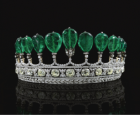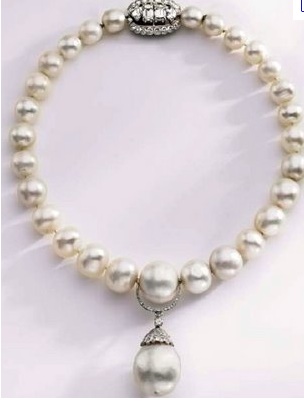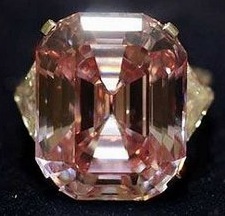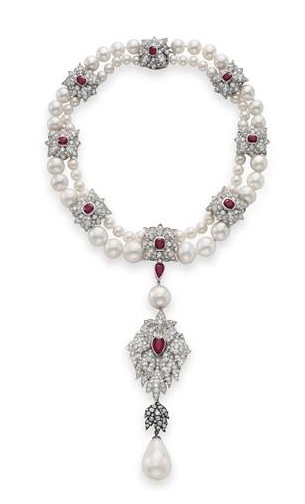Articles and News
AUCTION HOUSES: A FORMIDABLE COMPETITOR SNEAKS UP | September 13, 2011 (0 comments)

New York, NY—How do you add value to a diamond?
Sell it at auction. According to Lisa Hubbard, chairman of Sotheby’s for North and South America, and Gary Schuler, senior specialist international for Sotheby’s, $827 million worth of gems and jewelry were sold between the world’s two top international luxury auction houses, Christie’s and Sotheby’s, last year.
The two Sotheby’s experts were speakers at the Rapaport International Diamond Conference, held here Monday. Their talk focused on how the auction market for magnificent jewels has shifted from dealers to private individuals; in essence, cutting out the middlemen—like retail jewelers. While big or famous sales make news, the average price for a jewel sold at auction is less than $100,000, making them viable competitors for luxury jewelers.
Auctions always were a popular venue for moving large diamonds—usually stones far beyond the scope of what a typical upscale jeweler would sell. But whereas 90% of the buyers at auction used to be dealers in the trade, now that balance has shifted and between 65% and 70% of jewelry lots at Christie’s and Sotheby’s are sold to private individuals, usually in emerging markets. And, says Schuler, the sales usually are made without the buyer ever seeing or touching the stone. A buyer can expect to be guided through the acquisition by a tenured jewelry expert, and the transactions are 100% transparent, so trust is established from the outset. The experts, with the help of the auction houses’ considerable publishing muscle, help to educate buyers. Every sale catalog is practically a jewelry history textbook, with a wealth of information about the history and provenance of pieces, jewelry legends, lore, and facts, and much more. Educating and developing clients’ taste—and many start with none, says Hubbard—is just part of the auction houses’ role.
Beginning in the late 1980s to early 1990s, a new trend emerged of cutters bringing their larger goods directly to the auction houses to sell, rather than going through traditional trade channels, said Schuler. In 1990, total annual sales for the two major auction houses were about $300 million worldwide, compared to 2010’s figure topping $800 million.
What sparked the change?
It began with the 1987 landmark sale of the jewels belonging to the late Duchess of Windsor. That, says Lisa Hubbard, established the market for lifestyle single-owner market sales.

The Duchess of Windsor's jewels, such as this pearl and diamond necklace, sparked the trend for single-owner sales at auction.
“Provenance will push prices up to seven times beyond fair market value,” she said, if one describes fair market value as the price each stone would fetch individually, plus the metal and workmanship. But if the piece is signed by one of the great jewelry houses such as Cartier, that boosts the value, and if it’s owned by someone of great renown, that pushes the value up even more. In these cases, fair market value has very little to do with auction value.
“It’s like trying to evaluate a Monet according to the value of the paint and canvas,” she said. Hence, a Marcus & Company plique a jour enamel brooch, which was estimated to fetch between $40,000 and $60,000, sold for $302,500, and a diamond bracelet owned by legendary socialite Daisy Fellowes that was estimated between $630,000 and $700,000 sold for over $2 million.
Getting the estimates right is key, said Hubbard. Counter-intuitively, a lower estimate does not drive down the final sale price. “Estimates drive competition. Once you get your hand up, it’s very hard to take it down,” she told the audience.
Still, she said, for all the sales that blew the pre-sale estimates out of the water, expectations still need to be managed.
Auctions also are responsible for boosting numbers—and prices—of huge diamond sales. Sotheby’s was the first to offer a 100-carat D flawless, the “Star of the Season,” which was 100.10 carats and fetched $16.5 million.
The other spark that ignited the huge diamond boom was simply the availability of more large diamonds. According to a 1998 article written by Russell Shor in New York Diamonds magazine, more mega-stones began appearing in the late 1980s because De Beers had refined mining processes to reduce breakage. Russia began selling some of these after the end of the Soviet selling system, and a number of them went to auction.
Shor, now senior industry analyst for GIA, says mega-stone prices rose from approximately $50,000 per carat in the early 1990s to approximately $100,000 by 1996, at which point dealers pulled out of the market, saying prices were too high. Private buyers were rare then.
Not today. In 2007, the price-per-carat of a super stone was approximately $192,000 per carat; just two years later, in 2009, that price had jumped to $240,000 per carat.
But huge isn’t all the auction houses can do. In fact, most of their sales are far from huge, and indeed dip into the territory of many prestige jewelers. While the $20 million Wittelsbach or the $46.2 million Graff pink diamond sales make news, the average spend for jewelry is about $275,000, and the average price for a jewel at auction in 2010 was $93,000, says Schuler. These figures may not be everyday occurrences for a typical upscale independent jeweler—but neither are they unheard of.

This diamond ring, now known as the Graff Pink, was bought by the famed London jeweler Laurence Graff for a record $46 million.
“The best sells the better,” says Hubbard.
Why sell at auction? Hubbard outlined these reasons to the audience at the Rapaport event:
- Global brand recognition
- Transparency of the transaction
- Fiduciary fulfillment, making a competitive landscape for consignments
- Reach to every likely buyer in the world
- Each sale has comprehensive marketing and promotion across multiple channels from print to electronic media
- Targeted outreach to likely clients
- Cross marketing to collectors in all categories
The ability to cross-market to a broad spectrum of collectors makes auction houses formidable competition, along with a broad range of goods in a variety of styles, makers, and price points, all of course with a focus on rarity, quality, and a guarantee of attribution, says Hubbard.
“You put a case of jewelry up against a backdrop of Monet, and suddenly, ‘God, that looks affordable,’” says Hubbard. “You can buy a great piece of jewelry for $75,000, but you can’t get a painting for that.” So it’s no surprise that the previews for many other sales—art, automobiles, furniture, and so forth—will have a case of jewelry on display as well.
Buyers don’t have to wait for an auction to shop, either. Christie’s has a special department dedicated to discreet private jewelry sales. Whether one wishes to acquire or jettison a piece, Christie’s will tap its network of global contacts on the client’s behalf, and has negotiated private sales ranging from a five carat engagement ring to a 100 carat gem, all outside the auction hall. Sotheby’s, meanwhile, in a partnership with the Steinmetz Diamond Group, has its own collection of diamond jewelry, designed by creative director James de Givenchy. Pieces in this collection are surprisingly modern, incorporating such non-traditional materials as wood, rubber, and stainless steel. They’re also available anytime—not just at auction—from Sotheby’s salons in New York, London, and Hong Kong, and selling offices around the world.
As the balance of buyers shifted from trade to private individuals, Sotheby’s shifted its thinking and its dates, changing the New York fall jewelry auction from October—when dealers needed to buy—to December, when individuals are most motivated to buy.
“The sales now [in December] attract significantly more private buyers in addition to trade,” said. Sotheby’s even does some holiday direct marketing for jewelry. A brochure, for example, describes a 30.48-ct. oval diamond as “the perfect gift.”
Christie’s New York jewelry fall auction meanwhile, remains in October, but its ancient jewelry sale is December 7, its watch sale is December 16, and this year it is hosting what’s likely to be a jewelry-sale-of-all-sales: The Collection of Elizabeth Taylor, set for December 13 and 14 in New York.

This pearl, ruby, and diamond necklace was designed by Elizabeth Taylor with Al Durante of Cartier. It was a gift to the actress from Richard Burton, and will go up for auction at Christie's in December. It has a pre-sale estimate of $2,000,000 to $3,000,000.







